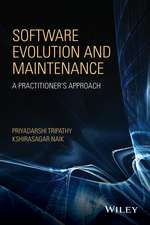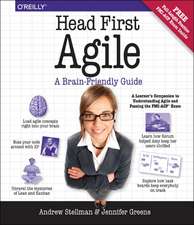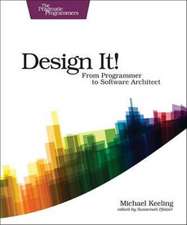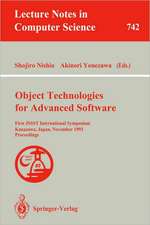Model-Based Design and Evaluation of Interactive Applications: Applied Computing
Autor Fabio Paternoen Limba Engleză Paperback – noi 1999
Preț: 328.79 lei
Preț vechi: 410.98 lei
-20% Nou
Puncte Express: 493
Preț estimativ în valută:
62.93€ • 68.38$ • 52.90£
62.93€ • 68.38$ • 52.90£
Carte tipărită la comandă
Livrare economică 21 aprilie-05 mai
Preluare comenzi: 021 569.72.76
Specificații
ISBN-13: 9781852331559
ISBN-10: 1852331550
Pagini: 212
Ilustrații: XII, 196 p. 62 illus.
Dimensiuni: 155 x 235 x 17 mm
Greutate: 0.32 kg
Ediția:Softcover reprint of the original 1st ed. 2000
Editura: SPRINGER LONDON
Colecția Springer
Seria Applied Computing
Locul publicării:London, United Kingdom
ISBN-10: 1852331550
Pagini: 212
Ilustrații: XII, 196 p. 62 illus.
Dimensiuni: 155 x 235 x 17 mm
Greutate: 0.32 kg
Ediția:Softcover reprint of the original 1st ed. 2000
Editura: SPRINGER LONDON
Colecția Springer
Seria Applied Computing
Locul publicării:London, United Kingdom
Public țintă
Professional/practitionerCuprins
1 Introduction.- 1.1 Why model-based design and evaluation of interactive applications ?.- 1.2 Basic concepts.- 1.3 Structure of the book and intended audience.- 1.4 Other sources of information.- 2 Model-Based Approaches.- 2.1 Task-oriented approaches.- 2.2 GOMS.- 2.3 Norman’s cycle.- 2.4 Task analysis methods.- 2.5 UAN.- 2.6 Petri Nets.- 2.7 UML.- 2.8 Formal Methods for HCI.- 2.9 Exercises.- 3 Analysis of Interactive Applications.- 3.1 Scenarios.- 3.2 Use Cases.- 3.3 Task analysis.- 3.4 Support for task identification in informal scenarios.- 3.5 Task and errors.- 3.6 Exercises.- 4 The Concurtasktrees Notation.- 4.1 Introduction to ConcurTaskTrees.- 4.2 Task allocation.- 4.3 Temporal relationships.- 4.4 Task types.- 4.5 Additional information associated with tasks.- 4.6 Structuring the task model.- 4.7 Example of ConcurTaskTrees specification.- 4.8 Tool support.- 4.9 Task models for cooperative applications.- 4.10 Exercises.- 5 Task-Based Design.- 5.1 Approaches to task-based design.- 5.2 Aspects to consider when designing user interfaces.- 5.3 Criteria for grouping tasks to be supported by the same presentation.- 5.4 Task-driven design of user interfaces.- 5.5 An example.- 5.6 Tasks for accessing databases.- 5.7 Task-oriented help.- 5.8 Adaptability.- 5.9 Adaptivity.- 5.10 Concluding remarks.- 5.11 Exercises.- 6 Architectural Models of Interactive Applications.- 6.1 Architectures for user interfaces.- 6.2 The interactor model.- 6.3 Composition operators for interactors.- 6.4 From the task model to the user interface architecture model.- 6.5 The transformation algorithm.- 6.6 Connecting interactors to support the information flow.- 6.7 An example of application of the transformation.- 6.8 Exercises.- 7 Patterns in Interactive Applications.- 7.1 Introduction.- 7.2Patterns.- 7.3 How to represent a task pattern.- 7.4 An example of a task pattern.- 7.5 Architectural patterns.- 7.6 An example of an architectural pattern.- 7.7 Relationships between tasks and architectural patterns.- 7.8 Tool support for patterns.- 7.9 Comments on patterns.- 7.10 Exercises.- 8 Usability Evaluation.- 8.1 Criteria for user interface evaluation.- 8.2 Introduction to approaches to usability evaluation.- 8.3 Comparing methods for usability evaluation.- 8.4 Remote usability evaluation.- 8.5 The RemUSINE method.- 8.6 Evaluation of RemUSINE.- 8.7 Exercises.- 9 Conclusions.- 9.1 Summarising the results described.- 9.2 Suggestions for open areas of interests.- References.
Caracteristici
The only up-to-date assessment of the state of the art in this field The only book to look specifically at the advantages of a systematic use of task models in the design/development of user interfaces






























